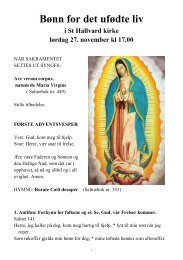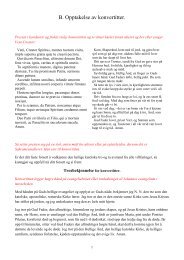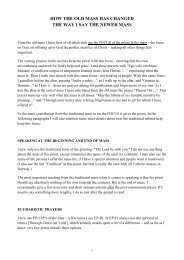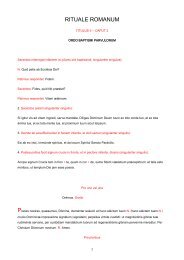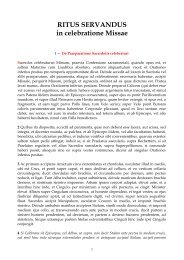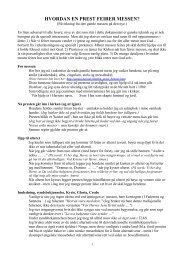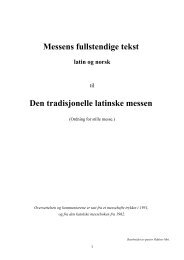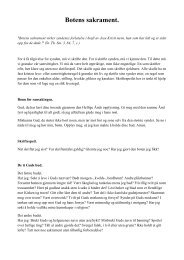oppgaven finner man i sin helhet her
oppgaven finner man i sin helhet her
oppgaven finner man i sin helhet her
Create successful ePaper yourself
Turn your PDF publications into a flip-book with our unique Google optimized e-Paper software.
2. Offisielle dokumenter om kirkemusikk mellom 1500 og 1900<br />
Den katolske kirke har uttalt seg om liturgisk musikk også før 1500-tallet – og<br />
uttalelsene handlet stort sett om det samme som de fra senere tid. Av historiske kilder fra<br />
før 1500-tallet kan nevnes St. Basilius 12 (329-379), St. Jeremia 13 (340/2-420), St.<br />
Nicetius 14 (død 563/6) og St. Thomas Aquinas på 1200-tallet 15.<br />
Trientkonsilet skilte mellom passende og upassende liturgisk musikk i 1562:<br />
“They (the ordinaries of each diocese) shall also banish from churches all those kinds of<br />
music, in which, whet<strong>her</strong> by the organ, or in the <strong>sin</strong>ging, t<strong>her</strong>e is mixed up any thing<br />
lascivious or impure; as also all secular actions; vain and t<strong>her</strong>efore profane conversations,<br />
all walking about, noise, and clamor, that so the house of God may be seen to be, and may<br />
be called, truly a house of prayer.” 16<br />
Pave Benedikt XIV uttalte seg detaljert om liturgisk musikk i <strong>sin</strong> encyklika Annus qui (19.<br />
februar 1749), der han på ny fordømte bruken av verdslig underholdningsmusikk i<br />
liturgien:<br />
”56. (…) each one can easily imagine what opinion pilgrims, from regions w<strong>her</strong>e musical<br />
instruments are not used, will have of us on coming to Our cities and hearing music<br />
common to theatres and ot<strong>her</strong> profane places (…) t<strong>her</strong>e is certainly no one who does not<br />
desire a certain difference between ecclesiastical chant and theatrical melodies, and who<br />
does not acknowledge that the use of theatrical and profane chant must not be tolerated in<br />
churches. (…)70. We also said that all condemn theatrical chant in churches and want a<br />
distinction made between the sacred chant of the church and the profane chant of the<br />
theater. (…) 71. (…) The Fat<strong>her</strong>s of the Council of Toledo, in 1566, after a long exposition of<br />
the qualities of the chant of the Church, conclude as follows: "It is absolutely necessary to<br />
avoid all that is theatrical in the music used for the chant of divine praises and everything<br />
that evokes profane themes of love or warrior feats dear to classic music. (…) 72. To<br />
conclude what We have to say on this argument, that is, on the abuse of theatrical<br />
compositions in churches (the abuse is evident and requires no words to demonstrate it),<br />
it suffices to mention that all the authors whom We have quotes above as being favorable<br />
to figurative chant and the use of musical instruments in churches, clearly say and testify<br />
that they have always meant and wished by their writings to exclude that chant and that<br />
music proper to platforms and to theaters, because they, like ot<strong>her</strong>s, condemn and despise<br />
such chant and music. (…)”<br />
12 St. Basilius: Exhortation to Youths as to How They Shall Best Profit from the Writings of Pagan<br />
Authors VII<br />
13 Sitert hos St. Thomas Aquinas: Summa Theologica, 2a-2ae, q. 91, art. 2.<br />
14 Sitert hos pave Benedikt XIV: encyklikalt brev Annus qui (19. februar 1749)<br />
15 St. Thomas Aquinas: Summa Theologica, 2a-2ae, q. 91, art. 2<br />
16 Trientkonsilets 23. sesjon, dekret om ting som skal observeres og unngås under messefeiringen<br />
10<br />
10



